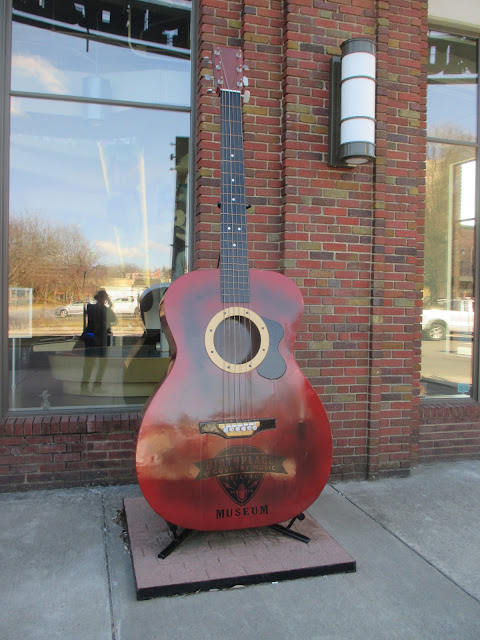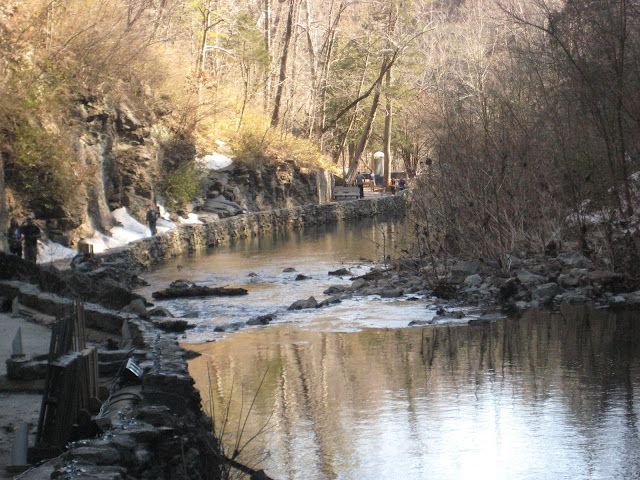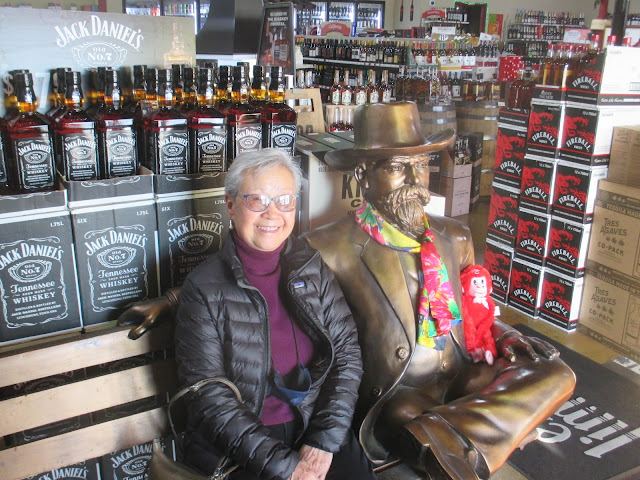February 7-11
The original plan for this trip left everything open-ended. We might not be back till the first week of March.
It has been the longest run I’ve ever made. We left Montclair on Nov. 28 and we’re not back yet. So far we’ve been on the road for a full 11 weeks.
We have a few more days to go.
The forecast includes some snow, which isn’t expected to amount to much. Nobody’s talking about another ice storm episode. So weather permitting, we’ll be back home on Valentine’s Day.
We did the cities—including Nashville, Memphis, Santa Fe, Phoenix—on the way West. We’ve been hitting a lot small towns, many of them in the middle of nowhere, on the way back.
We’ve had to spend a lot of time searching Google for places to eat. Pickings are slim, especially if you want a glass of wine with dinner.
I have not seen the inside of so many Texas Roadhouses or Outbacks before. In many cases, if we find an OK place we’ll go there twice.
That was the case in Lebanon. We went back to Demos’.
Joanna had meatballs with plain spaghetti. I had a couple of glasses of Cab with—well, I’m having a senior moment and can’t quite recall.
But it was OK, I’m sure.
Our next leg of the journey brought us to a Quality in on a hillside overlooking Kodak, Tennessee. I-40 runs through Kodak just north of Sevierville.
A highlight of the drive was a stop at a rest area. Outside on the lawn, there is a large sundial. The hours are marked by rows of plaques, each with the name of a Tennessee county.
Sevierville is famous for two reasons: It’s Dolly Parton’s birthplace and also home to the Smoky Mountain Knife Works, one of my favorite stores.
I must be wearing down, though. We were there on Tuesday the eighth and Wednesday the ninth. Even so, I didn’t even want to buy a switchblade on this trip. We skipped the drive through the delights of Pigeon Forge. And the Great Smoky Mountains National Park seemed so far away.
We may come back this way in a few months, or maybe next year, to explore more of the park.
We found a place called The Chop House that looked promising. So we tried it for dinner. It’s fun getting there. You have to do a U-turn on the state highway and then follow the arrows through a warren of crossing roads.
Then you come to Bass Pro Drive. The Bass Pro store dominates the hill on the north side of the Interstate.
We actually had tried the Chop House once before. On a trip out this way a few years ago, we stayed at Holiday Inn Express and were able to walk to the restaurant. That time, it was closed for some reason.
This time it was open for business, and not too crowded.
I tried the burger the first night, and it was all right. Not as tasty as the one at Egan’s in Montclair, but still better than most.
The second night, I had the small sirloin and some of Joanna’s prime rib roast. She gave me the rarest parts from the middle and ate the rest, including some of the pink meat, which is unusual for her. Cantonese palates avoid anything cooked rare.
The rib came au jus and dipping the meat gave it a pleasant kick.
Our next stop was John and Kim’s in Virginia on Thursday the tenth.
On the way, when we came into Virginia, we stopped at a rest area, which had information about something called The Crooked Road. It is a driving tour to key music-history sites in the region.
I think there is a stop connected with the Carter Family and other sites related to country music.
One of those stops was in Bristol, Virginia, billed as “the birthplace of country music.” There was a museum in town with that name.
Actually, the music was certainly not born there, but the business of packaging it and selling it to the nation was.
The company that would become RCA brought recording equipment to a building in Bristol and invited local people to perform. The recordings are known as The Bristol Sessions.
Among the first people to record there were Jimmy Rodgers, known as the Father of Country Music, and the Carter Family, who are downright legendary.
The museum has bits and pieces of recordings. I would have liked to hear some of them complete.
There were also short films. One, for instance, is about the sessions. Another explores gospel music.
It was a great place to spend an hour or so.
When we reached the house, we learned that John’s mother, my Aunt June, was there this time. She was visiting one of her daughters, Laura, when we stopped here in November.
She joined us for a terrific dinner. Very unusual flavors and, as usual, great wine.
The flavors were unusual because all the dishes were based on traditional Finnish recipes.
The house had been celebrating John’s Finnish heritage for his recent birthday. Kim had done the research into the food and had even posted Finnish phrases around the house.
We had Finnish meatballs which we ate on mashed potatoes with a cream gravy. There was a savory pastry that looked like a cheese Danish to be eaten with a topping of chopped egg and butter. Another dish combined ground beef with rice and cabbage.
Wines included a red blend from Venge Vineyards and another from California that was produced by a man from Finland.
Still another red was a Machete blend. Kim said you go “wow” twice with this wine. First for the fantastic mouth-filling flavor, and then for the sexy label, which parodies the old Blacksploitation movie ads.
Each label features a scantily clad model wearing a huge, Pam Grier 70s style Afro. She is always sitting in a provocative pose with a machete in hand.
John’s Finnish heritage is also mine, and we’re very proud of it. A lot of times you hear people joke about an ancestor run out of the old country for sheep stealing or some other infraction.
Well, in fact, our great-grandfather, Jacob, was indeed run out of Finland. He was a member of a progressive socialist party that, in addition to backing a graduated income tax, wanted the bars closed because it saw drink as the curse of the working class.
The family story goes that, when the czar started to allow taverns to reopen in the late 19th century, Jacob protested too loudly. The czar’s police gave him 30 days to get his affairs in order and his ass out of the country.
The next information we have of him is in a newspaper story from 1904. He was in trouble with the child welfare authorities in Philadelphia because two of his teen-age daughters were supporting the entire family by performing song and dance routines on the street.
Then there is a photo of him dated 1911. By that time, Jacob had bought a property that everybody in the family still calls “the farm.” He’s standing by a sand road in Weymouth, N.J., in front of his house. No kidding: he looks like Trotsky, cloth cap, boots, tweeds and whiskers.
Definitely one of our more colorful forebears.
Later in life he started writing his memoirs. Some distant relatives discovered the papers, which were in an obscure dialect of Finnish. They found a professor at a university in the Midwest who would translate it. They contacted my mother when they were taking a family collection to pay the translator. It was from those papers that I learned about Jacob’s socialist connections.
It was another great evening with John and Kim.
Friday, the eleventh, we were coming north on I-81 toward Winchester when we saw signs for Natural Bridge.
Want to see if we can find it? Sure.
The way was clearly marked and we found the Natural Bridge State Park with no trouble. It’s on U.S. Highway 11.
I had brought my stick from the car because I had no idea what kind of walking we were in for. The lady at the admissions counter said that we could drive if we couldn’t manage the steps.
How many steps? One hundred thirty.
I did about 90 or more in Mammoth Cave a few years ago and that was about my limit.
There is a one-way drive to the stream that formed the natural bridge. She had to radio below that a black Ford Fusion was coming down.
The bridge is created by a hole in a mountain more than 200 feet high and 90 across. U.S. 11 runs over the top.
You come to a walkway by Cedar Creek, a modest flow of water to have worn a hole that big, but I guess persistence pays if you have the time.
According to a sign, George Washington was here as a young man, hired to survey the area for Lord Fairfax. Washington climbed up about 25 feet and carved his initials in the rocks.
You can see them today, the sign said. I didn’t see them, but there is a rectangle of yellow paint across the Cedar Creek that may mark the spot.
Lots of other people over the years, it seems, followed Washington’s example. Climbing and carving are forbidden now.
Thomas Jefferson bought the property and built a small cabin nearby.
You can walk under the bridge to an open-air auditorium. Lots of kids were there throwing snowballs into the creek.
There was another sign in the park about a pageant or play that celebrates creation. I guess that should be Creation with a cap C, following the account in Genesis.
The program does not take place on park property, nor is the park service involved, the sign said. It’s sponsored by a separate, private organization and performed only when the park is closed.
Speaking of that, my word count tells me it’s time that this should close.
Be well, everyone.
Love to all
Harry and Joanna








No comments:
Post a Comment